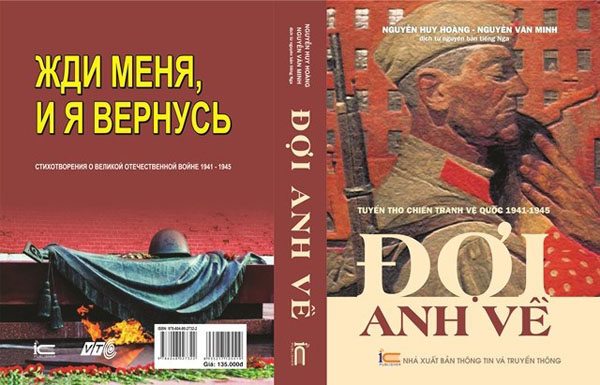
A collection of Russian poems on the Soviet Union’s patriotic war from 1941-1945 entitled "Wait for Me" has been translated into Vietnamese to celebrate the 100th anniversary of the October Revolution (1917-2017).

The Wait for Me poetry collection will be launched in
Vietnam (Photo: toquoc.vn)
The collection includes 180 poems from 24 poets written during the years from
1941 to 1945 when the country was fighting Nazi Germany.
Two Vietnamese translators Nguyen Huy Hoang and Nguyen Van Minh have worked
hard to collect the poems from prominent authors such as Konstantin Simonov,
Olga Bergholz, Yevgeny Yevtushenko and others.
In 1947, Simonov’s "Wait for Me" was translated into Vietnamese by
poet To Huu. It immediately became popular, and held significance among
Vietnamese people in the resistance war against the French.
The collection reflects the brutal reality of war through Russian characters
and their inner feelings. It shows the tragedy of battle, but is also
magnanimous and optimistic.
Lovers of Russian poetry will recognise many poems in this collection that have
been set to music, not only in Russia but also in Vietnam.
It is hoped that the collection will bring the Vietnamese an empathetic
understanding and pride for the patriotic war of the Soviet people and Soviet
literature.
The "Wait for Me" poem collection is hoped to act as a bridge between
literature of the two countries to contribute to consolidating their close
friendship.
It will be launched in Hanoi on November 3 at the 10th floor in 115 Tran Duy
Hung, Cau Giay district.
Those interested in Russia and especially Russian literature are invited to
join the event.
Source: VNA
With an increasingly vibrant and widespread emulation movement aimed at building cultured residential areas and cultured families, Yen Thuy District has been making steady progress toward improving both the material and spiritual well-being of its people, while fostering a civilized, prosperous, beautiful, and progressive community.
Once lacking recreational spaces and community facilities, Residential Group 2 in Quynh Lam Ward (Hoa Binh City) has recently received attention for the construction of a new, spacious, and fully equipped cultural house. The project followed the model of state support combined with public contributions in both labor and funding.
The "All people unite to build cultural life" movement, which has been effectively integrated with Kim Boi district’s socio-economic development goals, is fostering a lively spirit of emulation across local residential areas, hamlets, villages, public agencies, and enterprises. In addition, through the initiative, traditional cultural values are being preserved and promoted, while community solidarity and mutual support in poverty reduction and economic development are being strengthened.
A working delegation of the Hoa Binh provincial People’s Committee led by its Permanent Vice Chairman Nguyen Van Toan on June 11 inspected the progress of a project to build the Mo Muong Cultural Heritage Conservation Space linked to tourism services in Hop Phong commune, Cao Phong district.
Born and growing in the heroic land of Muong Dong, Dinh Thi Kieu Dung, a resident in Bo town of Kim Boi district, in her childhood was nurtured by the sweet lullabies of her grandmother and mother. These melodies deeply imprinted on her soul, becoming an inseparable part of her love for her ethnic group's culture. For over 20 years, this love for her hometown has driven Dung to research, collect, and pass down the cultural values of the Muong people to future generations.
In the final days of May, the Ethnic Art Troupe of Hoa Binh Province organized performances to serve the people in remote, mountainous, and particularly disadvantaged areas within the province. These were not just ordinary artistic shows, but they were the meaningful journeys aimed at spreading cultural values, enhancing the spiritual life of the people and contributing to the preservation of ethnic minority cultural identities.



